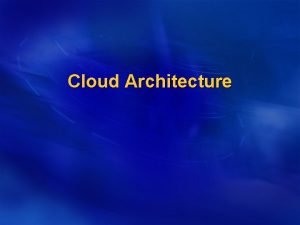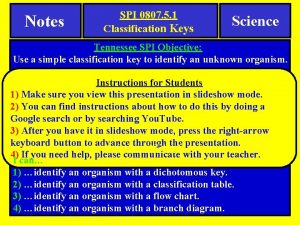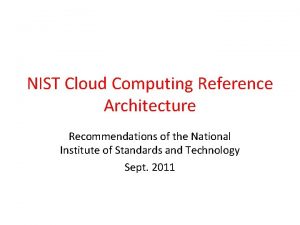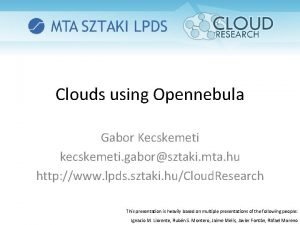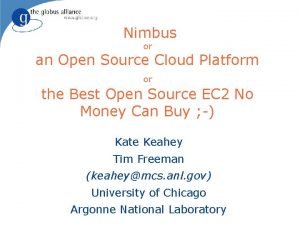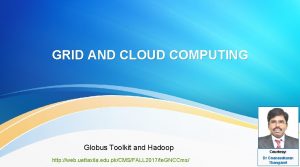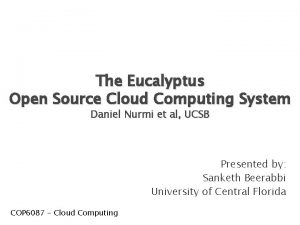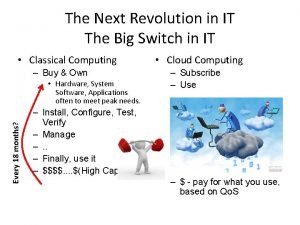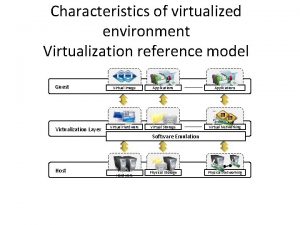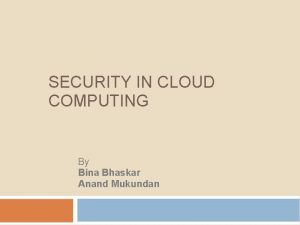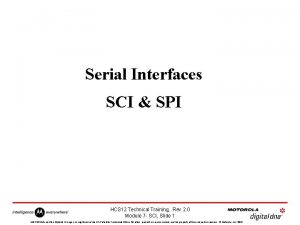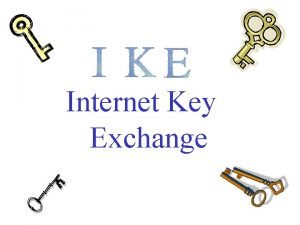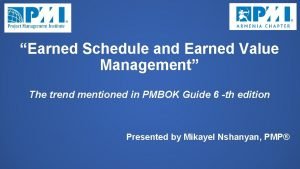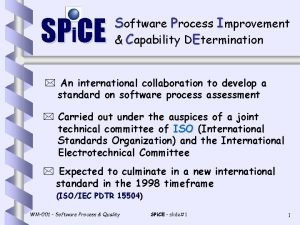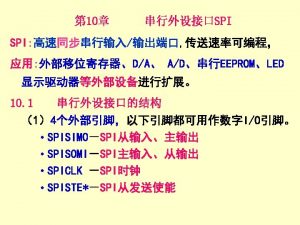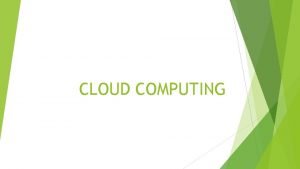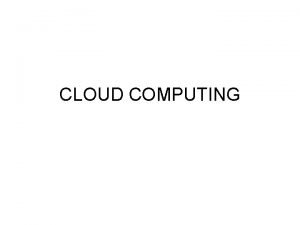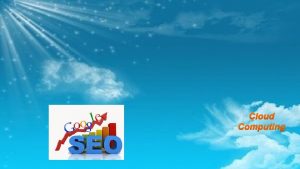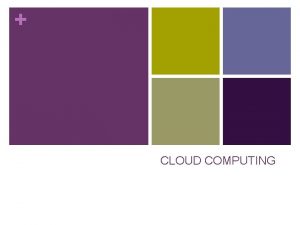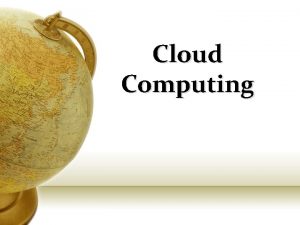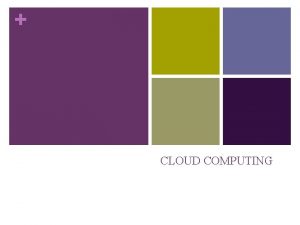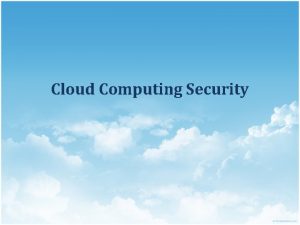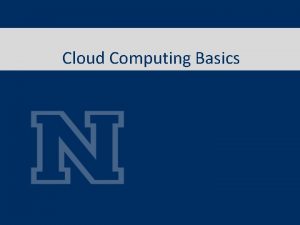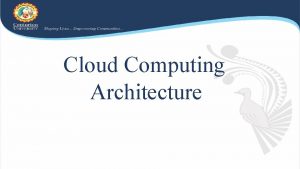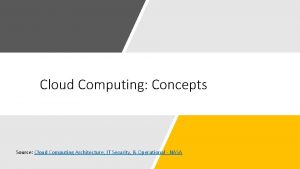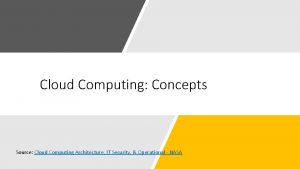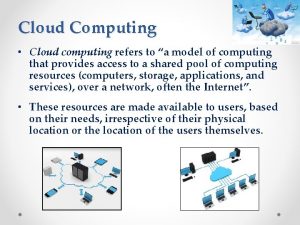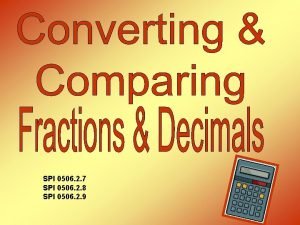Cloud Architecture SPI Model l Cloud Computing Classification


![Cloud Computing as A Service [9 ] Copyright © 2012, Elsevier Inc. All rights Cloud Computing as A Service [9 ] Copyright © 2012, Elsevier Inc. All rights](https://slidetodoc.com/presentation_image_h/0f781c93e9400dd96ddf289eda3f9411/image-3.jpg)















![Cloud Computing as A Service [9 ] Copyright © 2012, Elsevier Inc. All rights Cloud Computing as A Service [9 ] Copyright © 2012, Elsevier Inc. All rights](https://slidetodoc.com/presentation_image_h/0f781c93e9400dd96ddf289eda3f9411/image-19.jpg)

- Slides: 20

Cloud Architecture

SPI Model l Cloud Computing Classification Model – SPI - Saa. S: (Software as a Service) - Paa. S (Platform as a Service) - Iaa. S (Infrastructure as a Service)
![Cloud Computing as A Service 9 Copyright 2012 Elsevier Inc All rights Cloud Computing as A Service [9 ] Copyright © 2012, Elsevier Inc. All rights](https://slidetodoc.com/presentation_image_h/0f781c93e9400dd96ddf289eda3f9411/image-3.jpg)
Cloud Computing as A Service [9 ] Copyright © 2012, Elsevier Inc. All rights reserved. 2 -

l l l Infrastructure services share the physical hardware Platform services share the application framework Software services share the entire software stack.

l l l Amazon Elastic Compute Cloud (EC 2) is a classic example of Iaa. S Google App Engine is generally considered to be a Paa. S Salesforce. com is a well known example of Saa. S.

Some Iaa. S Offerings from Public Clouds : Copyright © 2012, Elsevier Inc. All rights reserved. 2 -

Paa. S Offerings from Public Clouds Copyright © 2012, Elsevier Inc. All rights reserved. 2 -





Cloud Delivery Model l l Public Cloud Private Cloud Partner Cloud Community Cloud Hybrid or Multi-sourced Delivery

l Public cloud: It has large set of the following features: - Off-premise - Elastisity - Flexible billing - Virtualization - Service delivery - Universal access - Simplified management - Affordable resources - Multi-tenancy - Service level management

l Private Cloud: only leverages some of the aspects of cloud computing - hosted on-premise, - scales “only” into the hundreds or perhaps thousands of nodes, - connected primarily to the using organization through private network links. - since all applications and servers are shared within the corporation the notion of multi-tenancy is minimized.

Public Clouds vs. Private Clouds : Characterist ics Public clouds Private clouds Technology leverage and ownership Owned by service providers Leverage existing IT infrastructure and personnel; owned by individual organization Management of provisioned resources Creating and managing VM instances within proprietary infrastructure; promote standardization, preserves capital investment, application flexibility Client managed; achieve customization and offer higher efficiency Workload distribution methods and loading policies Handle workload without communication dependency; distribute data and VM resources; surge workload is off-loaded Handle workload dynamically, but can better balance workloads; distribute data and VM resources Security and data privacy enforcement Publicly accessible through remote interface Access is limited; provide preproduction testing and enforce data privacy and security policies Example platforms Google App Engine, Amazon AWS, Microsoft Azure IBM RC 2 Copyright © 2012, Elsevier Inc. All rights reserved. 2 -

l Partner Cloud: Large IT providers, such as HP Enterprise Services or IBM Global Services, run data center for operations for large customers - manage services in their own facilities; - or on customer premises; - or on property of a third party

l Community Cloud: it caters a group of organizations with common set of requirements or objectives. l The most prominent examples are government clouds that are open to federal and municipal agencies.

l Hybrid or Multi-sourced delivery:
![Cloud Computing as A Service 9 Copyright 2012 Elsevier Inc All rights Cloud Computing as A Service [9 ] Copyright © 2012, Elsevier Inc. All rights](https://slidetodoc.com/presentation_image_h/0f781c93e9400dd96ddf289eda3f9411/image-19.jpg)
Cloud Computing as A Service [9 ] Copyright © 2012, Elsevier Inc. All rights reserved. 2 -

Cloud and Open Source l Cloud computing can leverage open source in many ways. - Self-supported Linux is by far the most popular opernating system from infrastructure servies - Cloud provider often use Xen and KVM for virtualization - Distributed cloud framwworks, such as Hadoop, are usally open source - Web-based API make the client device less relevant, which can reduce desktop license fees by adopting Linux, Google Chrome or other opensouce client. - Many Saa. S solutions leverage open-source software, such as Sugar. CRM
 Spi model in cloud computing
Spi model in cloud computing 8 level of classification
8 level of classification A composable component must be modular
A composable component must be modular What is the cloud computing reference architecture
What is the cloud computing reference architecture Opennebula architecture in cloud computing
Opennebula architecture in cloud computing Nimbus cloud computing
Nimbus cloud computing Globus toolkit architecture in cloud computing
Globus toolkit architecture in cloud computing Eucalyptus open source
Eucalyptus open source Green cloud computing architecture
Green cloud computing architecture Cloud computing reference model
Cloud computing reference model Characteristics of virtualization environment
Characteristics of virtualization environment Bina bhaskar
Bina bhaskar Conventional computing and intelligent computing
Conventional computing and intelligent computing Spi tides
Spi tides Spi vs sci
Spi vs sci Pengurusan kewangan panitia
Pengurusan kewangan panitia Sad spi
Sad spi Earned schedule calculation
Earned schedule calculation Spi fachschule erzieher
Spi fachschule erzieher Henri matisse radość życia
Henri matisse radość życia Software process improvement and capability determination
Software process improvement and capability determination
